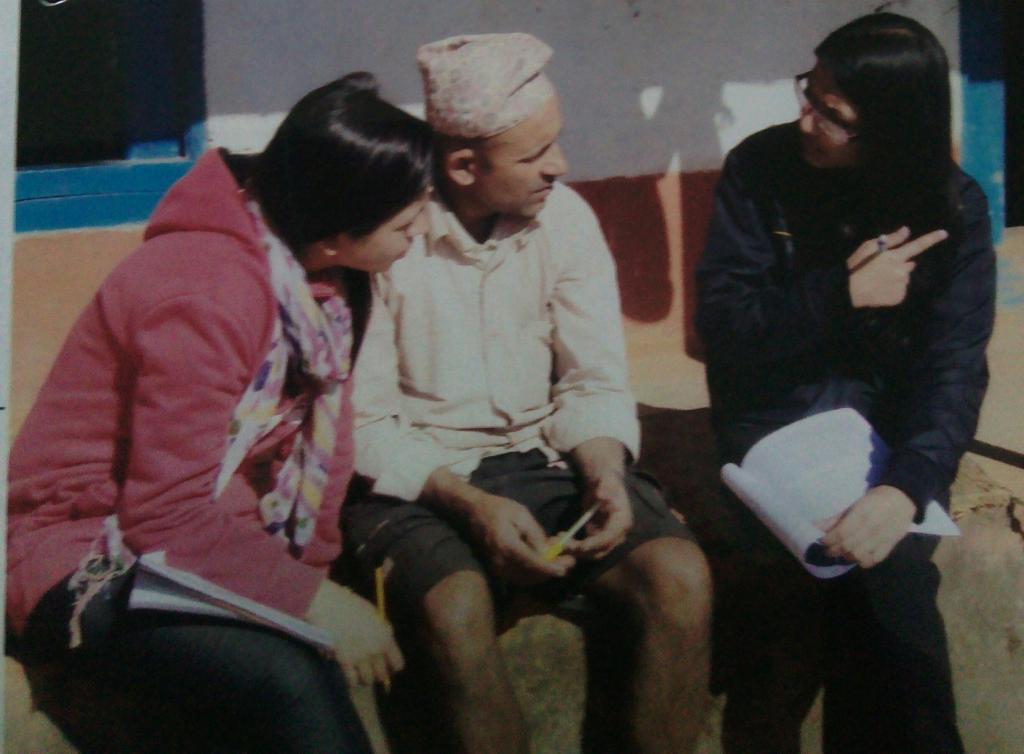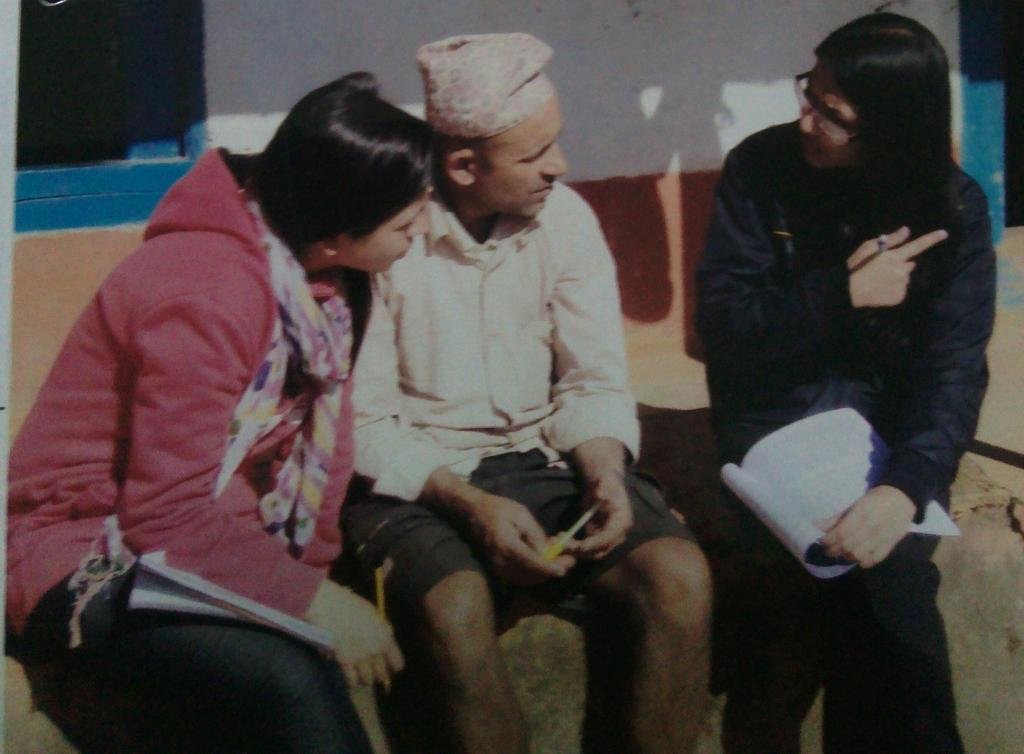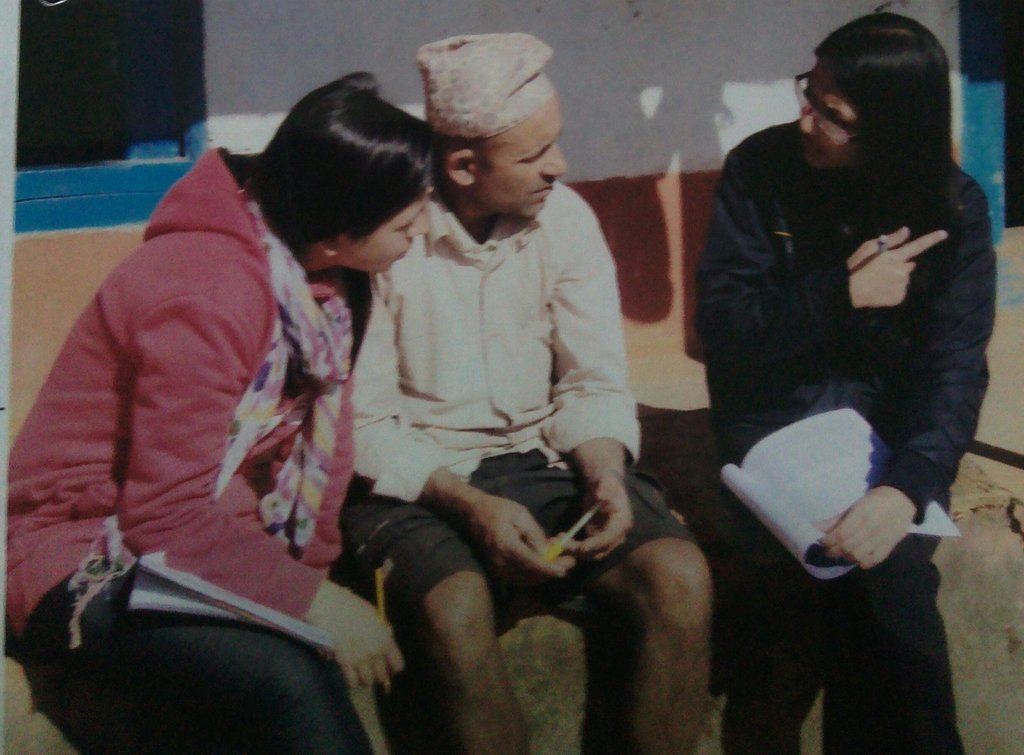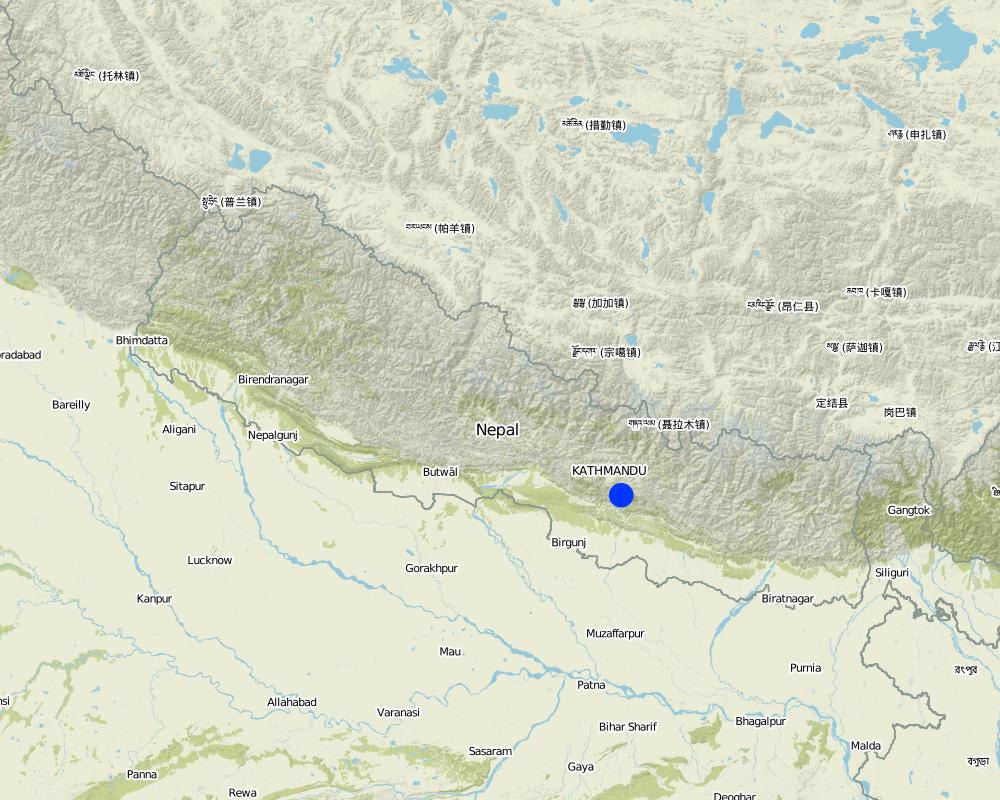Chyamrangbesi - A smoke free zone by using improved cooling stove [Népal]
- Création :
- Mise à jour :
- Compilateur : Sabita Aryal
- Rédacteur : –
- Examinateur : Fabian Ottiger
Chyamrangbesi- Dhuwa Muta Chhetra
approaches_2592 - Népal
Voir les sections
Développer tout Réduire tout1. Informations générales
1.2 Coordonnées des personnes-ressources et des institutions impliquées dans l'évaluation et la documentation de l'Approche
Nom du ou des institutions qui ont facilité la documentation/ l'évaluation de l'Approche (si pertinent)
Kathmandu University (KU) - NépalNom du ou des institutions qui ont facilité la documentation/ l'évaluation de l'Approche (si pertinent)
Sarada Batase Village Development Committee (Sarada Batase VDC) - Népal1.3 Conditions relatives à l'utilisation par WOCAT des données documentées
Quand les données ont-elles été compilées (sur le terrain)?
18/01/2014
Le compilateur et la(les) personne(s) ressource(s) acceptent les conditions relatives à l'utilisation par WOCAT des données documentées:
Oui
1.4 Références au(x) questionnaire(s) sur les Technologies de GDT
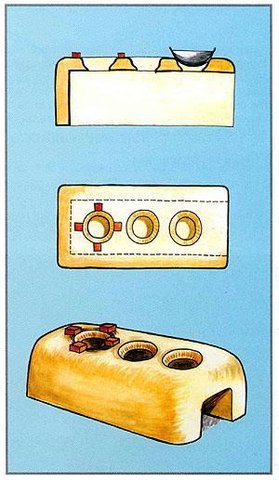
Khuwa making by the use of Improved stove [Népal]
The technology used is improved stove. An improved stove is a device that is designed to consume less fuel and save cooking time,convenient in cooking process and creates smokeless environment or reduction in volume of smoke against the traditional stove.
- Compilateur : Sabita Aryal

Improved Stove for household cooking use [Népal]
The technoloigy is engineered in such a way that there will be less consumption of wood and less emission of smoke.
- Compilateur : Sabita Aryal
2. Description de l'Approche de GDT
2.1 Courte description de l'Approche
The ways and means used to promote and implement to improved stove to improve human well-being and sustainable land use.
2.2 Description détaillée de l'Approche
Description détaillée de l'Approche:
Aims / objectives: The main objectives of the approach was to conserve forest and to improve human well-being
villagers facing major health risks due to smoke like eye itchiness, allergies, bronchitis.
Methods: The idea was proposed by REMRIC Nepal and was supported by Nepal Government. The approach was further enhanced by VDC and few local committes, public participation was an important part of the approach.
Stages of implementation: 1. Research : Questionnaires asked to land users and thier viewpoints noted.
2. Training : REMRIC provided trainiing to 9 people within the village
3. Financial support : Funding provided by VDC, REMRIC and other local bodies. Technician provided.
Role of stakeholders: Private contribution was not made. Organizations provided full financial funding and trained people. Involved organizations also did the research work and training people. A part from this, public participation had the significant role.
2.3 Photos de l'approche
2.5 Pays/ région/ lieux où l'Approche a été appliquée
Pays:
Népal
Autres spécifications du lieu :
Kavrepalanchok
Map
×2.6 Dates de début et de fin de l'Approche
Indiquez l'année de démarrage:
2069
Date (année) de fin de l'Approche (si l'Approche n'est plus appliquée):
2069
2.7 Type d'Approche
- fondé sur un projet/ programme
2.8 Principaux objectifs de l'Approche
The Approach focused mainly on SLM with other activities (Forest Production, Manure for agriculture, Improved human health, Kitchen efficiency)
The main objectives of the approach were to improve health hazards caused by the smoke trapped int he room and for forst conservation.
The SLM Approach addressed the following problems: 1. Lack of technical knowledge
2. Lack of cash to invest in SLM
2.9 Conditions favorisant ou entravant la mise en œuvre de la(des) Technologie(s) appliquée(s) sous l'Approche
disponibilité/ accès aux ressources et services financiers
- entrave
Land user not ready to invest in experimental technology.
Treatment through the SLM Approach: Local bodies, organization, VDC funded the whole project.
connaissances sur la GDT, accès aux supports techniques
- entrave
Dur to lack of technical knowledge and information
Treatment through the SLM Approach: REMRIC tarined 9 people; each from one ward
charge de travail, disponibilité de la main-d'œuvre
- entrave
Soil, brick, rods needed to carry from sometimes far distant areas.
Treatment through the SLM Approach: Land users volunteered to carry items themselves
3. Participation et rôles des parties prenantes impliquées dans l'Approche
3.1 Parties prenantes impliquées dans l'Approche et rôles
- exploitants locaux des terres / communautés locales
Jyotisahakari, Nawa prativa, Chakreshwor, Siddhartha
Community involvement. As physical activities are more involved, men are majorly involved. 33% only women involved
- Spécialistes de la GDT/ conseillers agricoles
REMRIC
- gouvernement local
Chyamrangbesi VDC
- gouvernement national (planificateurs, décideurs)
Nepal government
- organisation internationale
3.2 Participation des exploitants locaux des terres/ communautés locales aux différentes phases de l'Approche
| Participation des exploitants locaux des terres/ communautés locales | Spécifiez qui était impliqué et décrivez les activités | |
|---|---|---|
| initiation/ motivation | interactive | Public meetings, research questionnaires |
| planification | interactive | Interviews, public meetings |
| mise en œuvre | auto-mobilisation | responsibility of major and minor steps, casuale labor |
| suivi/ évaluation | interactive | Measurements/observations, interviews/questionnaires |
| Research | passive | Answer questionnaires, informed about SLM technology, but do not take the final decision. |
3.4 Prises de décision pour la sélection de la Technologie/ des Technologies
Indiquez qui a décidé de la sélection de la Technologie/ des Technologies à mettre en œuvre:
- principalement les spécialistes de la GDT, après consultation des exploitants des terres
Expliquez:
Initiations of approach by REMRIC and later involvement of local bodies and active involvement of VDC. However, research done actively and consulted land users about family size, thier input was considered valuable.
Decisions on the method of implementing the SLM Technology were made by mainly by SLM specialists with consultation of land users. The implementation was made by mutual agreement between the SLM specialists and the land users. However, the funding was solely done by SLM specialists.
4. Soutien technique, renforcement des capacités et gestion des connaissances
4.1 Renforcement des capacités/ formation
Une formation a-t-elle été dispensée aux exploitants des terres/ autres parties prenantes?
Oui
Spécifiez qui a été formé:
- exploitants des terres
Si pertinent, spécifiez le genre, l'âge, le statut, l'ethnie, etc.
Male, 25-35 years of age
Formats de la formation:
- entre agriculteurs (d'exploitants à exploitants)
- zones de démonstration
- réunions publiques
Thèmes abordés:
Interviews/questionnaires, setup, construct and design technology
4.2 Service de conseils
Les exploitants des terres ont-ils accès à un service de conseils?
Oui
Décrivez/ commentez:
Name of method used for advisory service: VDC; Key elements: Structure, Cost; But people have ample technical knowledge, also take advice from neighbours
Advisory service is inadequate to ensure the continuation of land conservation activities; Not that hard or costly to manage the technology. So, self sustaining is sufficient for continuation of technology.
4.3 Renforcement des institutions (développement organisationnel)
Des institutions ont elles été mises en place ou renforcées par le biais de l'Approche?
- non
4.4 Suivi et évaluation
Le suivi et l'évaluation font ils partie de l'Approche? :
Oui
Commentaires:
bio-physical aspects were ad hoc monitored by project staff through measurements; indicators: VDC, Trainees
area treated aspects were ad hoc monitored by project staff through observations; indicators: None
There were few changes in the Approach as a result of monitoring and evaluation: Once a year, REMERIC visits and monitors give suggestions.
There were no changes in the Technology as a result of monitoring and evaluation: Land user self-maintenance
4.5 Recherche
La recherche a-t-elle fait partie intégrante de l’Approche?
Oui
Spécifiez les thèmes:
- technologie
Donnez plus de détails et indiquez qui a mené ces recherches:
how many family members in each house
Research was carried out both on station and on-farm
5. Financement et soutien matériel externe
5.1 Budget annuel de la composante GDT de l'Approche
Si le budget annuel précis n'est pas connu, indiquez une fourchette:
- < 2 000
Commentez (par ex. principales sources de financement/ principaux bailleurs de fonds):
Approach costs were met by the following donors: government (Nepal Government); national non-government (REMRIC); local government (district, county, municipality, village etc) (VDC); local community / land user(s) (Chakreshwar, Nawa prativa, Siddhartha, Jyoti sahakari)
5.2 Soutiens financiers/ matériels fournis aux exploitants des terres
Les exploitants des terres ont-ils reçu un soutien financier/ matériel pour la mise en œuvre de la Technologie/ des Technologies?
Oui
Si oui, spécifiez le(s) type(s) de soutien, les conditions et les fournisseurs:
Technician provided
5.3 Subventions pour des intrants spécifiques (incluant la main d'œuvre)
- aucun
Si la main d'œuvre fournie par les exploitants des terres était un intrant substantiel, elle était:
- volontaire
Commentaires:
Technician was paid for construction of SLM Technology
5.4 Crédits
Des crédits ont-ils été alloués à travers l'Approche pour les activités de GDT?
Non
6. Analyses d'impact et conclusions
6.1 Impacts de l'Approche
Est-ce que l'Approche a aidé les exploitants des terres à mettre en œuvre et entretenir les Technologies de GDT?
- Non
- Oui, un peu
- Oui, modérément
- Oui, beaucoup
Less wood consumption so forest conservation. also, the ashes used as manure for agriculture.
Est-ce que l'Approche a autonomisé les groupes socialement et économiquement défavorisés?
- Non
- Oui, un peu
- Oui, modérément
- Oui, beaucoup
Did other land users / projects adopt the Approach?
- Non
- Oui, un peu
- Oui, modérément
- Oui, beaucoup
Did the Approach lead to improved livelihoods / human well-being?
- Non
- Oui, un peu
- Oui, modérément
- Oui, beaucoup
Improved health due to less smoke. Reduce in eye and throat problems.
Did the Approach help to alleviate poverty?
- Non
- Oui, un peu
- Oui, modérément
- Oui, beaucoup
Less wood required and improved health status
6.2 Principale motivation des exploitants des terres pour mettre en œuvre la GDT
- affiliation à un mouvement/ projet/ groupe/ réseaux
Involvement of big project
- conscience environnementale
Less smoke
- well-being and livelihoods improvement
Kitchen efficiency
6.3 Durabilité des activités de l'Approche
Les exploitants des terres peuvent-ils poursuivre ce qui a été mis en œuvre par le biais de l'Approche (sans soutien extérieur)?
- oui
Si oui, décrivez de quelle manière:
the approach was not difficult to implement. Simple concept was needed. Only cleanliness reqiured.
6.4 Points forts/ avantages de l'Approche
| Points forts/ avantages/ possibilités du point de vue de l'exploitant des terres |
|---|
|
1. Smoke no longer trapped in the room 2. Less wood consumption 3. Utensils are not damaged (How to sustain/ enhance this strength: Cleaning the stove plant trees, cooking multiple items at a time) |
| Points forts/ avantages/ possibilités du point de vue du compilateur ou d'une autre personne ressource clé |
|---|
|
1. Improved kitchen efficiency 2. Better channel for smoke outlet 3. Less wood consumption 4. Manure used for agriculture which kills the pests (How to sustain/ enhance this strength: Cleaning and self-maintainance Cleaning the outlet pipe from time to time cooking, boiling water cleaning and collecting the ashes) |
6.5 Faiblesses/ inconvénients de l'Approche et moyens de les surmonter
| Faiblesses/ inconvénients/ risques du point de vue de l’exploitant des terres | Comment peuvent-ils être surmontés? |
|---|---|
| cooks faster than traditional stove however slower than modern stove |
| Faiblesses/ inconvénients/ risques du point de vue du compilateur ou d'une autre personne ressource clé | Comment peuvent-ils être surmontés? |
|---|---|
|
1. Smoke outlet system is slightly poor 2. When one spot is used for cooking the other one has to be used too |
raise the outletpipe vertically Some sort of door that can be open and closed when needed. |
7. Références et liens
7.1 Méthodes/ sources d'information
- visites de terrain, enquêtes sur le terrain
- interviews/entretiens avec les exploitants des terres
Liens et modules
Développer tout Réduire toutLiens

Khuwa making by the use of Improved stove [Népal]
The technology used is improved stove. An improved stove is a device that is designed to consume less fuel and save cooking time,convenient in cooking process and creates smokeless environment or reduction in volume of smoke against the traditional stove.
- Compilateur : Sabita Aryal

Improved Stove for household cooking use [Népal]
The technoloigy is engineered in such a way that there will be less consumption of wood and less emission of smoke.
- Compilateur : Sabita Aryal
Modules
Aucun module trouvé


